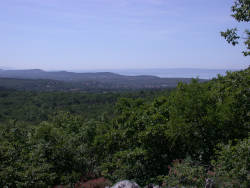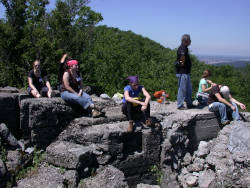Grotta del Monte Ermada
Useful Information


| Location: |
Walking trails from Brestovica pri Komnu in Slovenia and Medeazza or Ceroglie in Italy.
(45.79521421336915, 13.628204031601944) |
| Open: |
no restrictions. [2021] |
| Fee: |
free. [2021] |
| Classification: |
 Karst Cave Karst Cave
 World War I World War I
|
| Light: | bring torch |
| Dimension: | |
| Guided tours: | self guided |
| Photography: | allowed |
| Accessibility: | no |
| Bibliography: |
Franco Gherlizza (2011):
Grotte di guerra sul Carso,
Itinerari ipogei in alcune grotte della Grande Guerra sul Carso triestino e goriziano.
112 pagine a colori - stampa tipografica - Trieste, 2011. Edito da "La Biblioteca del Piccolo" - Editoriale FVG spa.
 pdf
pdf
|
| Address: |
Museo all’Aperto del Monte Ermada, Ceroglie, Duino-Aurisina, 34011 Duino-Aurisina TS, Tel: +39-04313-87130.
Gruppo Speleologico Flondar, Villaggio del Pescatore, 102, I-34013 Duino Aurisina (TS), Tel: +39-040-209075-208853, Cell: +39-339-6908950. Trieste Infopoint, via dell’Orologio, 1 (angolo Piazza Unità d’Italia), I-34121 Trieste, Tel: +39-040-3478312. E-mail: |
| As far as we know this information was accurate when it was published (see years in brackets), but may have changed since then. Please check rates and details directly with the companies in question if you need more recent info. |
|
History
| World War I | part of the Austro-Hungarian fortifications. |
| 1969 | cave rediscovered. |
Description
Grotta del Monte Ermada (Cave of Trench Hill) is located below the summit of Monte Ermada (Trench Hill). It accommodates the Austro-Hungarian troops who fought on the frontier. The natural entrance leads to a slide of soil and stone. The debris conceals the terraced flooring, built by the military to accommodate the troops. At the end of this ramp a central chamber opens, which has an 100 m long artificial tunnel to the surface. It is recommended to use the artificial tunnel as it is in better condition than the natural entrance.
The main chamber contains numerous remains of World War I. Metal brackets with insulators made of porcelain on the wall are the remains of the electric light. In one section of the cave was a generator which produced the electricity to illuminate the bunker. A staircase of concrete steps leads down to a lower platform. Be careful, as the staircase is partly destroyed.
This cave is part of the Museo all’aperto del Monte Ermada (Open-air Museum of Mt. Ermada). It is a trail at the southern slope of Monte Ermada (Trench Hill, 323 m asl), between the villages Medeazza and Ceroglie. It shows the defensive line fortified in September 1916 following the 6th Battle of the Isonzo. The Italian victory had forced the Habsburg Imperial Army to abandon Monfalcone and move to this hill. The great Italian victory, which cost ten thousands of lives, changed the frontier by 6 km.
Mt. Ermada and the surrounding hilltops had massive strategic and practical advantages. They could control both the Valley of Brestovizza (Brestovica Dol, now part of Slovenia) and the passage to Trieste. Trenches, observation posts, and bunkers for soldiers were built in no time, creating an insurmountable barrier for the Italians. The sinkholes and the natural caves of the Karst Plateau were perfectly adapted to the needs of the war. All assaults by the Italian Third Army between the 8th and 10th Battle of the Isonzo were rejected. In the 10th battle alone 36.000 Italian soldiers were dead, 124.000 wounded or prisoner of war, on Austrian side 17.000 soldiers were dead, 108.000 wounded or prisoner of war.
 Search DuckDuckGo for "Grotta del Monte Ermada"
Search DuckDuckGo for "Grotta del Monte Ermada" Google Earth Placemark
Google Earth Placemark Open-air Museum of Mt. Ermada (visited: 02-JUN-2021)
Open-air Museum of Mt. Ermada (visited: 02-JUN-2021) Index
Index Hierarchical
Hierarchical Countries
Countries Maps
Maps